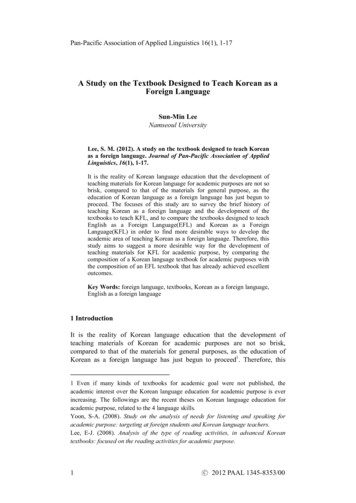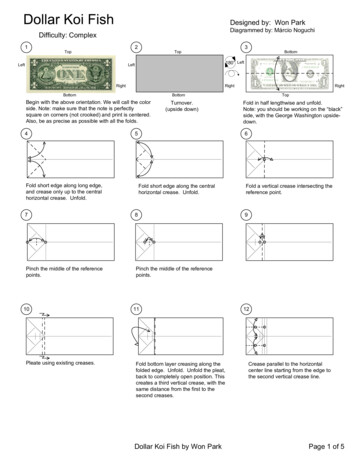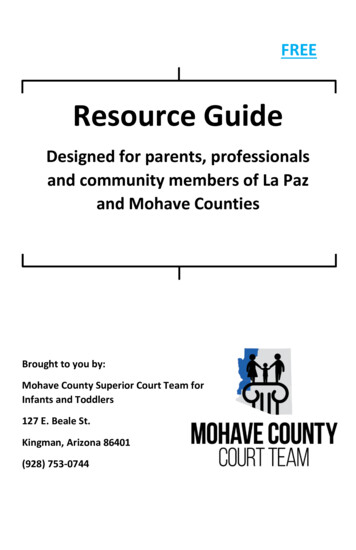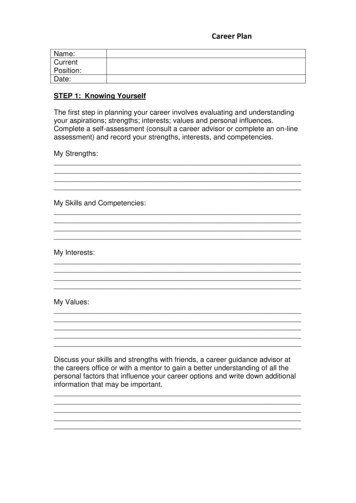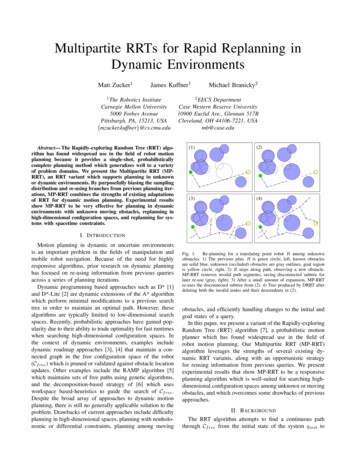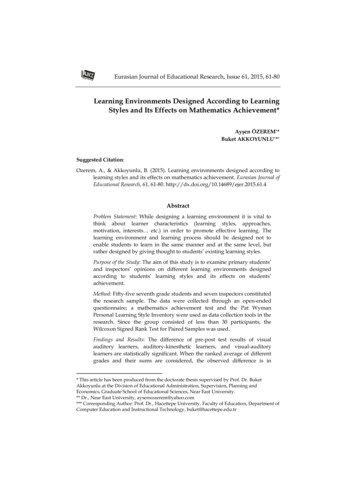
Transcription
Eurasian Journal of Educational Research, Issue 61, 2015, 61-80Learning Environments Designed According to LearningStyles and Its Effects on Mathematics Achievement*Ayşen ÖZEREM**Buket AKKOYUNLU***Suggested Citation:Ozerem, A., & Akkoyunlu, B. (2015). Learning environments designed according tolearning styles and its effects on mathematics achievement. Eurasian Journal ofEducational Research, 61, 61-80. roblem Statement: While designing a learning environment it is vital tothink about learner characteristics (learning styles, approaches,motivation, interests etc.) in order to promote effective learning. Thelearning environment and learning process should be designed not toenable students to learn in the same manner and at the same level, butrather designed by giving thought to students’ existing learning styles.Purpose of the Study: The aim of this study is to examine primary students’and inspectors’ opinions on different learning environments designedaccording to students’ learning styles and its effects on students’achievement.Method: Fifty-five seventh grade students and seven inspectors constitutedthe research sample. The data were collected through an open-endedquestionnaire; a mathematics achievement test and the Pat WymanPersonal Learning Style Inventory were used as data collection tools in theresearch. Since the group consisted of less than 30 participants, theWilcoxon Signed Rank Test for Paired Samples was used.Findings and Results: The difference of pre-post test results of visualauditory learners, auditory-kinesthetic learners, and visual-auditorylearners are statistically significant. When the ranked average of differentgrades and their sums are considered, the observed difference is in* This article has been produced from the doctorate thesis supervised by Prof. Dr. BuketAkkoyunlu at the Division of Educational Administration, Supervision, Planning andEconomics, Graduate School of Educational Sciences, Near East University.** Dr., Near East University, aysenxozerem@yahoo.com*** Corresponding Author: Prof. Dr., Hacettepe University, Faculty of Education, Department ofComputer Education and Instructional Technology, buket@hacettepe.edu.tr
62Ayşen Özerem & Buket Akkoyunlupositive ranking, meaning it is in favor of post-test results. According tothese results, different learning environments designed for visualauditory-kinesthetic learners have a positive effect on student grades. Themajority of the students stated that the aforementioned activities used inthe mathematics lesson could also be used in other school subjects.Conclusions and Recommendations: Student responses emphasized thatlearning environments should be designed according to student learningstyles. Inspectors underlined that learning styles designed according tostudents’ individual learning styles may increase student success. Inaddition, inspectors thought that some of the advantages of designinglearning environments according to students’ learning styles included anopportunity to learn fairly, an increase in student motivation towards thelesson, and enabling students to learn at their own pace. In the upcomingstudies, student behaviors and motivations towards environmentsdesigned according to students’ learning styles will be analyzed.Keywords: Learning styles, achievement, students' opinionsIntroductionLearning is a very complex process. One’s general ability, cognitive process,emotions, motivation, developmental characteristics, readiness, previousexperiences, social environment, and the culture of his/her community are variablesthat affect the process of learning. Affected by so many factors, individuals havedifferent learning processes.In a learning environment there are many stimuli created by the teacher. Astudent collects the information that s/he chooses from among these stimuli.Additionally, every student might have different senses s/he prefers to use. Whenone student tries to learn by listening to the teacher, another might be interested inthe behaviors of the teacher or the script and pictures of the book open in front ofhim/her. Every student has a different strategy of coding information to their longterm memory. Some try to learn by giving meaning to them at once, whereas sometry to learn by repeating. Some students can remember what they learned easily andquickly. Conversely, some have difficulty remembering and organizing what theyknow. Some students like learning in groups, and some might find it disturbing(Erden & Altun, 2006).Researches on educational sciences have shown that there are learningdifferences among students and the only way for learning to take place in the propersense is to find an individual’s learning style and arrange the learning environmentaccordingly. Learning differences have affected learning and teaching processes,individualizing learning processes and taking these learning differences into thecenter of learning. Students have their own methods of obtaining information andprocessing it: while some focus on data and operations, others are better at theoriesand mathematical models. For some, written and verbal explanations are more
Eurasian Journal of Educational Research63effective for others it can be visual elements like drawings, shapes, and graphics.Some learners prefer interactive environments, while others might prefer workingindividually. All of these differences in learning preferences are signs of theirdifferent learning styles (Felder, 1996).The learning style of an individual not only shows how s/he learns but also givesinformation about how to design a learning environment. Although all the studentsin a class are at the same age, at the same developmental phase, and offered mutualchances by the teacher, different behaviors, learning styles, and achievements in aclass can be observed. Dwyer (1996) emphasized that no matter the learningenvironment, students’ learning styles should be taken into consideration whiledesigning the learning process. Many of the researches underlined the importance ofidentifying students’ learning styles and how helpful this can be in preparing thelearning/teaching environment (Boydak, 2001; Claxton & Murell, 1987). In schoollearning, if the learning environment is designed according to student learningstyles, their academic achievements increase (Erden & Altun, 2006).Learning StylesThere are many definitions of learning styles in the literature. Shuell (1986)explained that learning styles are the different ways used by individuals to processand organize information or to respond to environmental stimuli. Jensen (1998)defined learning style as a way of thinking, comprehending, and processinginformation. Keefe and Ferrell (1990) underlined learning style as the pattern ofcognitive, emotional, and physiological characteristics affected partially byindividuals’ way of perceiving, interacting with, and reacting to learningenvironments. According to Dunn and Dunn (1993, learning style is a path that mayvary from one person to another, which starts with concentration and continueswhen information is received and located in the mind. Jensen (1998) defined learningstyle as a way of thinking, understanding, and processing data. Wyman (2006)defined learning styles as an individual’s different way of receiving and processinginformation. If an individual knows his/her learning style, s/he can upgrade his/herlearning level to the maximum, which can result in lifelong learning success. Wyman(2006) divided learning styles into three categories: audio, visual, and kinesthetic.According to Wyman, if a student’s learning is identified and arrangements aremade, the student’s success can be enhanced. The most important thing whilemaking necessary adjustments is preparing the learning environment to be suitablefor each learning style.Analysis of the various definitions concludes that every individual has a uniquelearning style. Even though they are learning in the same environment, for the sameduration, and they are internalizing the same facts and events, their approaches canbe different. Although learning styles are not permanent or fixed components, ittakes time. Because of this, it is easier and more effective to arrange the classroomenvironment, learning materials, and learning styles related to the learning styles,rather than expecting students to adapt to the existing system. Learning styles play avital role in an individual having an effective learning life. As a result, it is a
64Ayşen Özerem & Buket Akkoyunlunecessity to design learning environments suitable for the individuals (Hood, 1995).As Cela, Sicilia, and Sánchez-Alonso (2015) underlined, learning styles influencedifferent learning environments, such as social networks in an e-learning class.Learning EnvironmentA learning environment has many meanings according to the way it is used.Besides its definition as an indicator of learning task (Tynjala, 1999), psychosocialenvironments in class (Henderson, Fisher, & Fraser, 2000), and virtual environmentsformed with computer and internet technologies (Fulkerth, 2002), it is also used in avery wide range of ways. Studies on learning environments focus on behaviormanagement, classroom rules and discipline, motivation of students, teachingmethods, the set-up of classroom tools (tables, desks, etc.), and even the color of theclassroom (Chesebro & McCroskey, 2002; Slavin, 2000; Snowman & Biehler, 2003).Learning environment the surroundings that make it possible for the learner to findsolutions to their problems and to have access to the materials to help them achievetheir goals. To make lifelong learning possible, the experiences in the learningenvironment are crucial. These experiences are formed of the interaction between thelearner and the learning environment. The role of the interaction with sensorystimulants (tools and materials) is very important in a learning environmentdesigned for learners. In today’s educational concept, the insight of learner-centerededucation not only enables materials to be designed according to students’ differentlearning characteristics, but also enhances the efficient learning environments withthe help of the developed technology. Learning environments designed according tostudents’ needs improve student motivation and success by using a variety ofmaterials. In this context, when instructional technologies are analyzed, they can beclassified as visual environments, auditory environments, or both. As Vinales (2015)mentioned in her study, the learning environment is a key factor for studentlearning. It provides crucial exposure for the students and helps students developtheir repertoire of skills, knowledge, attitudes, and behaviors in order to meet 21stcentury competencies.Designing the learning environment is a complicated process including manydifferent variables. Unless a learning environment is constructed in advance, it is notonly inadequate in learning goals but also an environment without control. In orderto avoid chaos in the learning environment, either the teachers or the instructionaldesigners should prepare and check it in advance (Wilson, 1995). Instructionaldesigners cannot design a learning environment that can be applied to every kind oflearning. This is not possible even though the characteristics of learning and thelearner are taken into consideration. During the learning process, learners use morethan one sense: they use visual and auditory information, perceive data from theoutside, choose the meaningful data, and combine new data with existing data.Besides, learners with different learning styles activate the aforementioned mindprocesses. These experiences can be acquired by interacting with the learningenvironment (Bolliger, 2004). Studies have shown that learning environments thatconsider learner characteristics affect academic success in a positive way (Chen &
Eurasian Journal of Educational Research65Duh, 2008; Dascalu, Bodea, Moldoveanu, Mohora, Lytras, & de Pablos, 2015;Millwood, Powell, & Tindal, 2008).The Aim of the StudyWhile designing the learning environment, it is vital to think about learnercharacteristics (learning styles, approaches, motivation, interests, etc.) in order topromote permanent and effective learning. Multimedia environments address morethan one sense and teach by giving importance to individual differences, whichincrease success and make permanent learning possible. Dwyer (1996) mentionedthat learning environment and learning process should be designed not to enablestudents to learn in the same manner and at the same level, but rather should bedesigned by giving thought to students’ existing learning styles. The aim of the studyis to examine primary school students’ and inspectors’ opinions on different learningenvironments designed according to students’ learning styles and its effects onstudents’ mathematics achievement. Therefore, this study seeks the answers to thefollowing questions:a. What are the learning styles of the students?b. Is there a difference between mathematics pre- and post-test results of studentswho have different learning styles (visual-auditory, auditory-kinesthetic, and visualauditory–kinesthetic)?c. What are the students’ opinions about learning environments designedaccording to students’ learning styles?d. What are the inspectors’ opinions about learning environments designedaccording to students’ learning styles?MethodResearch DesignThe study is a one-group pre-test – post-test design. There is a single selectedgroup under observation, with careful measurement done before applying theexperimental treatment and then measuring after (Gay, 1987). In the one-group pretest – post-test design, a single group is measured or observed not only after beingexposed to a treatment of some sort, but also before (Fraenkel, Wallen, & Hyun,2012). In this design, the effect is taken to be the difference between the pre-test andpost-test scores.Research SampleThe convenience sampling method was chosen for this study. Conveniencesampling is a statistical method of drawing representative data by selecting peoplebecause of the ease of their volunteering or selecting units because of theiravailability or easy access (Lavrakas, 2008). For this study, the convenience samplingmethod was chosen because the subjects were readily available for the researcher, aswell as other research advantages. The researcher was a mathematics teacher of thestudy group, and she designed the learning environment in their mathematics
66Ayşen Özerem & Buket Akkoyunlulessons. This sampling method was also useful in documenting that quality of thedesigned learning environment for the research (Lavrakas, 2008). However,convenience sampling has limitations. The most obvious criticism about conveniencesampling is that it is not representative of the entire population. It has limitations ingeneralization and inference making about the entire population. Since the sample isnot representative of the population, the results of the study cannot speak for theentire population.Fifty-five seventh grade students and seven inspectors constituted the researchsample. 56.5% of the students were girls and 43.6% were boys. 47.3% of the studentshad a visual auditory learning style, 23% had auditory kinesthetic, and 29.1% hadvisual auditory kinesthetic. Four of the inspectors were male and three were female,with seven years of work experience in the field.Research Instrument and ProcedureThe data for the study were collected through open-ended questionnaires, theMathematics Achievement Essay Test, and the Pat Wyman Personal Learning StyleInventory.Open-ended questionnaires: The researchers developed open-ended questionnairesfor students and inspectors in order to examine their opinions on learningenvironment. The student questionnaire had four questions: “What do you thinkabout the Transformation subject?”, “Did you have any trouble during the course?”,“If so, what was it?”, and “Would you like to be taught the same way in othercourses? Why?”. The inspector questionnaire had three questions: “Do you thinkstudents’ achievements would increase if learning environments were designedaccording to student learning styles?”, “Why?”, and “What are the advantages oflearning environments designed according to student learning styles?”. Questionswere prepared and sent to subject specialists, then were redesigned according totheir suggestions.Mathematics Achievement Essay: A Mathematics Achievement Essay on theTransformation unit was prepared to define students' mathematics achievement;these were used as pre- and post-test. The achievement test aimed to ask questionsthat triggered students’ interpretation, analysis, arguments, and evaluation skills.The exam consisted of 10 questions of increasing difficulty (knowledge,interpretation, application, and analysis). The questions were designed according totheir difficulties; in other words, the difficult questions were graded with a higherscore. The test was conducted on fifty-two 8th grade students who had already beentaught the unit for testing the reliability and validity of the essay. The test - retestmethod and inter rater reliability were used for reliability. The essay was given to thegroup as pre- and post-test in four weeks. The correlation coefficient was found to beα .79. For inter rater reliability, three different examiners graded the ten questionsindependently and the correlation coefficient changed between 0.89 and 0.94, whichwas quite high. Kendall's coefficient of concordance was used to test inter-raterreliability, which was found as .52 (χ2 315.16, sd 3, p .05). Criteria validity was
Eurasian Journal of Educational Research67used to test the validity, and 8th grade students’ essay scores were compared to theirmathematics report marks and the correlation between them was found to be .61.Pat Wyman Personal Learning Style Inventory: The Pat Wyman Personal LearningStyle Inventory was used to identify students’ learning styles and was developed byPat Wyman (1998). The Learning Style Inventory consists of 36 questions. Studentscheck the statements he/she agree with. The Pat Wyman Personal Learning StyleInventory was adapted into Turkish by Erdem & Akkoyunlu (2006) and itsvalidation and the alpha reliability coefficient were calculated. The reliability of thescale was .73.Data AnalysisThe data was analyzed using SPSS (The Statistical Package for the SocialSciences). Since the group consists of less than 30 participants, the Wilcoxon SignedRank Test for Paired Samples was used.Implementation of the ProcessFirst, daily lesson plans were prepared according achievements in theTransformation unit. The learning styles of students were defined and learningenvironments were designed considering their learning styles. TransformationGeometry was chosen because it is taught in schools only by using writtendocuments and tracing paper; in addition to this, it was important to thoroughlyinvestigate how auditory, kinesthetic, and visual learners learn. Moreover,Transformation Geometry can develop students’ geometry experiences,imaginations, thinking abilities, and spatial skills. With the help of TransformationGeometry, students not only associate mathematics and art, but also understand theimportance of mathematics and its application to our daily lives. For instance, whenstudents look at a rug and its repeated and rotated patterns, they can look at theirenvironment from another perspective. Because of this, Transformation should betaught to students at very early ages; the fact that reflection and rotation can beobserved in many natural constructions and natural appearances should beemphasized.Studies show that Transformation geometry can develop students’ abstractconcepts such as consistency, symmetry, analogy, and parallelism and can help toimprove their three-dimensional thinking abilities (Flanagan 2001; Hannafin,Truxaw, Vermillion, & Liu, 2008). The objects used in the activities were chosen assuitable for the subject matter and the age group. Students were given theopportunity to actively innovate in the given activities and there was an attempt towiden their previously acquired knowledge. Instead of giving students ready shapes,they were encouraged to design their own shapes, analyze them, and makecomments about the activity. Both individual and group activities were used. Most ofthe prepared activities were presented in PowerPoint, supported with colorfulpictures, animations, and voice effects.
68Ayşen Özerem & Buket AkkoyunluFindingsWhat Are Student Learning Styles?The students’ learning styles were identified by the Pat Wyman PersonalLearning Style Inventory. According to Table 1, most of the students have visualauditory learning styles. 47.3% of the students have visual-auditory, 23.6% haveauditory-kinesthetic, and 29.1% have visual-auditory-kinesthetic. When distributionsof learning styles are analyzed, the majority of students are found to be visualauditory learners and the proportions between auditory-kinesthetic and visualauditory-kinesthetic are very close.Table 1.Distribution of Students’ Learning StylesLearning ditory-KinestheticTotalN28131455%47,323,629,1100Is There a Difference Between Mathematics Pre- And Post-test Results of Students WhoHave Different Learning Styles (Visual-Auditory, Auditory-Kinesthetic, and VisualAuditory-Kinesthetic)?The pre- and post-tests scores of students’ who had different learning styles(Visual-Auditory, Auditory-Kinesthetic, and Visual-Auditory-Kinesthetic) werecalculated separately (Table 2). As seen in Table 2, there is a difference betweenstudents’ pre- and post-test results. The mean score of students who have visualauditory learning styles in pre-test is 9.72 and 27.30 in the post-test. The mean scoreof students with auditory kinesthetic learning styles in pre-test is 9.09 and 28.23 inthe post-test. The mean score of kinesthetic learners is 9.53 in pre-test and 27.03 inpost-test.Table 2.The Pre- and Post-Tests Scores of Students According to Their Learning StylesPre-testStdPost-testLearning Stddeviation6,187,045,156,06
Eurasian Journal of Educational Research69The difference between the pre-post test results of students who have differentlearning styles are statistically tested and presented in Table 3. Since the groupconsists of less than 30 participants, the Wilcoxon Signed Rank Test for PairedSamples was used.Table 3.Wilcoxon Signed Rank Test for Paired Samples for the Significance of Pre-Post Test ResultDifferences of Visual - Auditory LearnersVisual-AuditoryPost-test – Pre-testnMean Rank Sum of RanksNegative Ranks 111-4,600*.000Positive ive Ranks 111-3,110*.002Positive icNegative Ranks 000-3,297*.001Positive Ranks147,5105Tries0Total14*Related to Negative Ranking Base.The difference of pre-post test results of visual auditory learners are statisticallysignificant (z -4.600; p .05). When the ranked average of different grades and theirsums are considered, the observed difference is positive, meaning it is in favor ofpost-test results. According to these results, different learning environmentsdesigned for visual-auditory learners have a positive effect on student grades.The difference of pre-post test results of auditory-kinesthetic learners arestatistically significant (z -3.110; p .05). When the ranked average of different gradesand their sums are considered, the observed difference is positive, meaning that it isin favor of post-test results. According to these results, different learningenvironments designed for auditory-kinesthetic learners have a positive effect onstudent grades.The difference of pre-post test results of visual auditory kinesthetic learners arestatistically significant (z -3.197; p .05). When the ranked average of different gradesand their sums are considered, the observed difference is positive, meaning that it isin favor of post-test results. According to these results, different learningenvironments designed for visual-auditory-kinesthetic learners have a positive effecton student grades.
70Ayşen Özerem & Buket AkkoyunluWhat Are the Students’ Opinions About the Learning Environments Designed According toStudents’ Learning Styles?A questionnaire including three open-ended questions was prepared todetermine student opinions on learning environments designed for their differentlearning styles. Students’ responses are presented in Table 4 about the designedlearning environments for different learning styles.Table 4. Students’ Responses about the Designed Learning Environments for Different LearningStylesQ1: What do you think about the way the Transformation subject is taught?It was very good and educational. (E.T)We did good instructional activities. (S.K)I think it contributed to our learning (D.B)The way the teacher taught was very good. (N.O)It was very good. I had so much fun. (I.O)The time flew, it was very clear. I learned a lot (O.Y)It was a good lesson. The way the lesson was taught was fun. (S.S)It was good. You baffled us. (S.B.O)It was fun, we learned better by drawing, writing, and then doing activities. (O.M.A)Because Transformation is more of a visual subject and our learning styles weretaken into consideration the lesson was taught better. (E.G.S)Q2: Did you have any difficulties during the lesson? If so, what were they?I did not face any difficulties; I had so much fun. (D.B)I did. I could not do some of the shapes or I did them incorrectly and our teachercould not help me because of the intensity of the lesson. (İ.E.S)The time was limited; I think the time was not enough for all the activities. (E.G.S)It is a very good and entertaining subject; with the way our teacher taught and theactivities, I understood it very well. (A.A)Q3: Would you like these activities to be used in other lessons? Why?Yes, it would be fun. (E.T)Yes, definitely, I can learn in an easier way. (S.K)Yes, I can still remember it. (B.A)Yes, the subjects can be learned better. (I.O)Yes, because these activities helped me to learn the subject better. (O.Y)No, because I think these activities are not suitable for all lessons. (A.A)Yes, because we can revise more. (I.O)Yes, because the lessons would be more fun and it can increase our love of school.(E.R)Yes, because the lessons are more entertaining. (D.K)Yes, because the activities are more memorable; since we have fun while learning themotivation is higher. (E.G.S)Yes, it can help us remember, keep us motivated, have fun, and to look forward tothe lesson. (A.A)
Eurasian Journal of Educational Research71Analysis of responses for question 1 show the students they are generallyappreciative of the presentation of the lesson. According to student feedback, it isunderstood that Transformation was taught in an entertaining way, including manydifferent kinds of activities. The students expressed that teaching the lesson byconsidering student learning styles contributed to a better learning andcomprehension of the subject (Table 3).Analysis of responses to question 2 show some of the students thought that thetime was not enough; some said that because of the classroom intensity they couldnot get enough attention from the teacher. In addition, other students said that theteaching style and supporting the lesson with different activities helped the lesson tobe understood (Table 3).The majority of the students said that the aforementioned activities used in theMathematics lesson could also be used in other lessons. Other findings from thisstudy include that these activities revised the lesson, enabled students to betterunderstand the subject, and increased their motivation. Since the lesson wasenjoyable, it made the students like Mathematics and made the lesson entertaining.The student responses emphasize the importance of creating entertaining learningenvironments.What Are the Inspectors’ Opinions About the Learning Environments Designed Accordingto Students’ Learning Styles?A questionnaire of three open-ended questions was also prepared to learninspectors’ opinions on learning environments designed for different learning styles.The inspector responses to questions on learning environments designed fordifferent learning styles are presented in Table 5.Table 5.Inspectors’ Responses about the Designed Learning Environments for Different LearningStylesQ1: Do you think learning environments designed for different learning styles canimprove students’ achievement?I1: Yes, every student has a different way of learning. It has to be designed.I2: Yes, because every student is different and every student has different verbal andmathematical intelligence.I3: Yes, if multiple intelligence theory is taken into consideration, it proves it.Individual learning methods vary.I4: Yes, since multiple intelligence theory is individual differences, when a learningenvironment is designed accordingly to learning styles success will be improved.I5: For learning styles, what students learn is less important than how they learn. Forpermanent learning, how students learn is an important factor to increase studentsuccess.I6: Yes, because every student has a different learning style and pace. If learningenvironments are designed according to students’ individual needs, both perceptionand success will increase.I7: Learning environments designed according to learning styles increases student
72Ayşen Özerem & Buket Akkoyunlusuccess. Every human being has different perception characteristics. Environmentsdesigned suitable for individual differences will increase student success.Q2: In your opinion, what are the a
Purpose of the Study: The aim of this study is to examine primary students’ and inspectors’ opinions on different learning environments designed according to students’ learning styles and its effects on students’ achievement. Method: Fifty-five seventh grade stude

